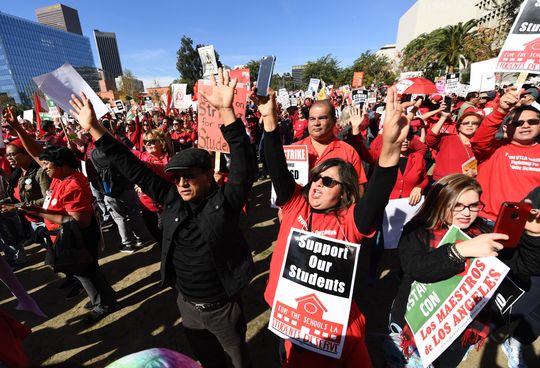By: Erin Richards.
The Los Angeles teachers’ strike is behind us, but more tension lies ahead: Teachers in Virginia plan to rally at the Capitol on Monday for more education funding. Back in California, Oakland teachers will vote this week on whether to strike.
In Denver, a strike planned for Monday is on hold, pending a possible state intervention. In West Virginia, Republicans kicked off another showdown with teachers after GOP leaders drafted legislation that would tie new pay raises to limits on unions, larger class sizes and a sweeping enactment of school choice.
All this comes on the heels of walkouts and strikes by teachers in 2018.
What teachers want
In general: higher salaries, smaller class sizes, more support staff and more respect. Over the past decade and a half, demands on teachers in terms of testing and accountability have gone up while their pay and authority have not.
“The complexity of our jobs is that our working conditions are the kids’ learning conditions,” said Daniel Jocz, a high school history teacher in Los Angeles and a 2016 California Teacher of the Year.
The day after the strike, Jocz, 39, subbed for a colleague’s class period and found himself trying to control 42 sixth-grade students in one room.
“That many sixth-graders is exhausting,” he said. “Now imagine that on a bigger scale, where you’ve got kids speaking multiple languages and all needing help.”
Los Angeles teachers, who plan to strike Monday, want pay raises. But they’re also asking for smaller classes. A teacher explains how crowded it gets. USA TODAY
Labor is having a moment. Will it last?
Teacher walkouts in Republican-controlled states such as West Virginia, Oklahoma, Kentucky and Arizona last year garnered national attention. Generally, the teachers gained pay increases and additional money for schools. Then came Los Angeles, an enormous urban school system in a blue state. A 6 percent pay increase over two years for teachers was largely settled before the strike began, which freed teachers to campaign for additional resources, such as more school nurses and smaller class sizes – which they won.
“We are rebuilding community,” said Randi Weingarten, president of the American Federation for Teachers. “What you’re seeing is a labor movement that is learning how to become a movement again.”
The wins may be short-lived. West Virginia teachers won a 5 percent pay raise after a statewide strike last year, but Republicans unveiled draft legislation Jan. 24 that would tie additional pay raises to larger class sizes. The bill would send more money to private schools and charter schools, which would be authorized in West Virginia for the first time.
Mike Antonucci, who scrutinizes unions for the nonprofit education news website The 74, said a second coming of labor has been heralded before, “only to see more school choice and right-to-work laws enacted, and the unionization rates drop.”
Teachers unions are «over-promising what they can achieve,” he said.
More money for schools. Maybe.
Lawmakers in many red states are offering to increase education spending – a pivot from several years ago when the party sought to cut school budgets.
Georgia Gov. Brian Kemp proposed a $3,000 salary increase for teachers to help with retention, he said.
The Texas Senate proposed a $5,000 raise for teachers. New Mexico lawmakers proposed funneling more money into public schools and boosting the base pay of mid-career teachers from about $44,000 per year to $50,000.
Related: Teachers love their jobs but can’t pay their bills, poll shows
In Florida, lawmakers are considering whether to give schools more flexibility on how to pay teachers. Maryland Gov. Larry Hogan, a Republican, proposed a state budget last week that includes $347 million more for schools over last year’s amount.
Will the increases happen?
Proposals are one thing; passing them into law is another.
For example, Indiana Gov. Eric Holcomb encouraged districts to raise teacher pay, but the proposal doesn’t set aside additional money to fund those increases.
More on Indiana: Teacher walkout possible if General Assembly ignores pay issue
Teachers in office: Wins by Tony Evers, Jahana Hayes, Okla. teachers show ‘new beginning’
Richard Ingersoll, a professor at the University of Pennsylvania’s Graduate School of Education who studies the educator workforce, said he’s skeptical.
“It’s very hard to increase salaries because there are so many teachers,” he said.
Pensions and benefits costs are a problem
As America wrestles with how much to pay teachers, health care costs and pensions eat up money that could go toward raises or classrooms.
In Los Angeles, employee benefit costs increased 138 percent from 2001 to 2016, census data show.
“Teacher salaries have not kept up with inflation over the past 20 years, but total compensation has,” said Chad Aldeman, a senior associate partner at the nonpartisan think tank Bellwether Education Partners.
School districts and states must fulfill the promises they made to older and retired workers, while the same perks are cut for new workers.
“As of today, it’s the worst time to become a teacher in terms of benefits,” Aldeman said.
How to deal with it?
- Holcomb, Indiana’s Republican governor, proposed paying off part of the education system’s pension liability to free up about $70 million in school budgets.
- Arizona began requiring teachers and public workers to make higher payroll contributions into their pensions.
- Michigan’s Republican Gov. Rick Snyder signed controversial legislation in 2017 that steers newly hired teachers into 401(k)-style plans rather than pension systems.
Fuente de la reseña: https://www.usatoday.com/story/news/education/2019/01/26/teacher-strike-denver-oakland-west-virginia-virginia/2680582002/























 Users Today : 67
Users Today : 67 Total Users : 35460198
Total Users : 35460198 Views Today : 93
Views Today : 93 Total views : 3418876
Total views : 3418876